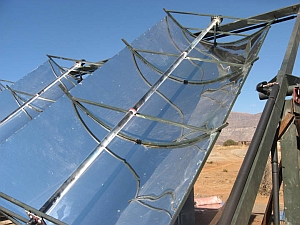A not-for-profit company established by students and alumni at Massachusetts Institute of Technology is testing a solar energy system that generates electric power and hot water for isolated health clinics in Africa. The team led by Matthew Orosz, a recent Ph.D. recipient in mechanical engineering, will describe its work in an upcoming issue of the ASME Journal of Engineering for Gas Turbines and Power.
The system developed by the MIT team uses a curved parabolic solar mirror they call a solar trough (pictured left) that directs the solar energy to a pipe with refrigerant fluid, along the center line of the trough. The system uses the heated fluid as a form of reverse air-conditioner that generates electric power from the confluence of the heat generated in the pipe and the colder air outside. The heated fluid in the pipe can also provide heat, hot water, and if configured, refrigeration to the attached building.
Orosz founded a not-for-profit company now called STG International, with fellow student Amy Mueller and faculty advisor Harold Hemond, to develop the solar technology into practical products. A prototype of the patented system has been installed at a small health clinic in Matjotjo Village in the southern African nation of Lesotho, where Orosz served for two years as a Peace Corp volunteer. The isolated clinic would otherwise have to rely on a diesel generator or photovoltaic solar power that Orosz says has higher lifetime costs than the solar trough.
The reliable power and hot provided by solar trough system not only has economic benefits for the clinic, they also help encourage more hygienic practices. The mountain location of the clinic and temperate climate of Lesotho means the clinic’s staff needs to work during the winter, including days with freezing temperatures. “We’ve had nurses tell us they avoid washing their hands in the winter, because the water is so cold,” says Orosz, “so hot water is very welcome.”
The prototype system was first installed in 2008, which provided a proof of concept of the technology, but also uncovered some operational and management issues. For example, Orosz and colleagues discovered the system required a skilled operator to adjust the temperatures, pressures and voltages as conditions changed, which diverted time and resources from the clinic’s small medical staff.
The STG International team has since developed a computerized control system that allows the system to run almost unattended, and once fully installed, the only maintenance anticipated for the system is washing the huge mirrors every six months. The new control system is being tested at Eckerd College in Florida, and will be installed at the Matjotjo Village clinic early next year.
In 2013, STG International plans to install four more systems at other schools and clinics in Lesotho, with help from the country’s ministries of health and education and three local engineers hired by the company. The MIT team hopes to create a local source of jobs and revenues, with further systems built, owned, and operated by local companies set up for that purpose.
In the following video, Orosz tells more about the solar trough and the project in general.
- Engineering Students Build Inexpensive IV Drip Controller
- North Africa, Middle East Entrepreneurial Programs Unveiled
- Interactive Map Shows Off-Grid Energy Technology Sites
- World Bank Contract Awarded for Off-Grid LED Tests
* * *


 RSS - Posts
RSS - Posts
You must be logged in to post a comment.